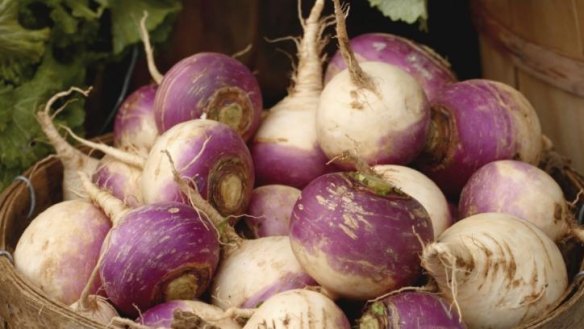How to grow turnips in Canberra gardens

Few root vegetables can be planted now but you can plant turnips and beetroots. Both are quick growing and should be harvested when the bulbous root top is still tender. [You can refer back to the 24 November 2015 edition of Good Food for the guide on growing beetroot.]
Turnips have a long history and have travelled the world. They are easy to grow and the bulbous roots can be served raw, or cooked. The raw turnip root is crisp and refreshingly sweet. When steamed or braised, the turnip is tender; it will absorb the flavours of any juices in which it is cooked. The foliage of the turnip is also a delicious green when lightly cooked. Use the young turnip leaves in stir fry cooking.
There is evidence of turnips were being grown in Babylon close to 3000 years ago and Russia also lays claim to growing the original turnip. Early varieties grown during the days of the Greek Empire were given Greek place names. The English name was to come from the Anglo Saxon word turn (meaning round) with the Roman categorization name napus, after it was corrupted to the Anglo Saxon naep.
Turnips were an important staple food across Europe for centuries until the potato was brought from the Americas. Turnip seeds were taken to the New World early in settlement, firstly to Canada and then to other more southern colonies. Colonists in Virginia began growing turnips in the early years of the 17th century and American Indians adopted them quickly as a good, easy growing food source.
Dig in some well finished compost into the soil before planting. Do not incorporate any fresh manures into a garden bed when growing any of the turnip, beetroot or carrot crops or you will have the roots fork.
Turnips are a sub group of the brassica family and this is important in two respects. Firstly the seeds will struggle to germinate unless the soil is tamped down and made firm. Secondly, the foliage will need to be protected from the cabbage moth. As with other brassicas, I would recommend that you obtain a section of the pestguard netting and cover the entire bed. (A 5 m x 2.9m net from the web based Green Harvest supplier costs $20.95.)
Turnips will produce a good crop within several weeks of planting. For the faster growing varieties, there will be usable bulbs and delicate leaves for the kitchen after just five weeks but the full sized bulb will take around 10 weeks from planting. Plant seeds to a depth of 15mm deep, leaving a space between seeds of 8-10cm. Make rows around 30 cm apart.
Purple top, white globe is the name of the very popular turnip, grown in many countries. The largish bulb above the ground takes on a reddish-purple tinge but the section below remains white. Purple top Milan is a flatter variety which is another quick maturing turnip. The Gold Ball Sweet turnip has deep golden yellow flesh. It has a very fine flavour but will take at least two weeks longer to grow than the other mentioned varieties.
Slow Cooked Pot au Feu
This traditional French slow cooked dish can be prepared using a crock pot or a heavy duty cooking pot on the stove. Historically, it served to use up the available poorer cuts of meat but even these, when slow cooked with the marrowbones and the herbs, produced a wonderful, flavoursome winter meal.
1.5 kg rump steak
4 beef shanks with marrowbone
3 medium onions
6 medium turnips
4 medium parsnips
3 medium carrots
5 potatoes
4 leeks
6 cloves garlic, chopped
2 bay leaves
4 sprigs parsley
4 sprig thyme
1 tsp whole black peppercorns
water to cover
Vegetable garnish
2 celery stalks
350 gms baby carrots
200 gms baby turnips
Additional
½ winter cabbage
vinaigrette
gherkins
Dijon mustard
Peel the onions, turnips, parsnips, potatoes and carrots. Cut the leeks in half. Brown the steak in a heavy based cooking pot, with a little olive oil. Cook the onion with the garlic until it is translucent. Add in the beef shanks and all of the vegetables to the cooking pot (or crock pot). Mix in the fresh herbs and add the peppercorns and the beef stock. Cook on a low heat for 8-10 hours.
Vegetable garnish
Cut the celery stalks into 5cm lengths and slice vertically in half. Add the celery, baby carrots and baby turnips to the slow cooker for the last 30 minutes
Pot au feu soup
Strain off the broth and skim off any fat. Thicken with flour on a low heat, stirring gently. Retain and serve as a clear soup later.
Serving
Slice the cabbage and cook separately. Slice up the meat and serve the pot au feu with a generous helping of cabbage. Drizzle the vinaigrette dressing over the pot au feu and offer sliced with gherkins and Dijon mustard as accompaniments.
This week in the Garden
Plant out a row or two of kale, mizuna, open leaf lettuces and selected spinach. Plant rocket and radish.
Plant out remaining garlic cloves in hilled up beds with lots of compost. Plant the small cloves quite close to produce a harvest of spring garlic. Weed all garlic planting regularly.
When adding old vegetable plants to the compost heap, cut up larger leafed plants such as corn zucchini and beans, to speed up the decomposition process.
If you still have Granny Smith apples on your trees, leave them hanging until the first frosts, to produce a very sweet, ripe eating apple.
You can begin pruning your peach and nectarine trees as soon as the leaves have fallen. Remove any mummified fruit still hanging on the branches.
Owen Pidgeon runs the Loriendale Organic Orchard near Hall.